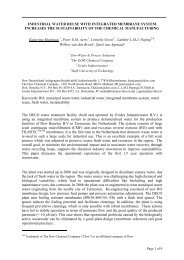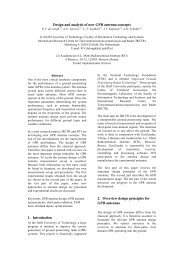Lecture Notes CT 4860 Structural Pavement Design Design of ...
Lecture Notes CT 4860 Structural Pavement Design Design of ...
Lecture Notes CT 4860 Structural Pavement Design Design of ...
Create successful ePaper yourself
Turn your PDF publications into a flip-book with our unique Google optimized e-Paper software.
design and the material selection should be such that some major defect types are under control<br />
meaning that they don’t appear too early and that they can be repaired easily if they appear.<br />
Major defect types that can be observed on flexible pavements are:<br />
- cracking,<br />
- deformations,<br />
- disintegration and wear.<br />
A short description <strong>of</strong> these defect types and their causes is given hereafter. Later in these notes<br />
it will be described how these defect types are taken care <strong>of</strong> in pavement design.<br />
2.1 Cracking<br />
Cracks in pavements occur because <strong>of</strong> different reasons. They might be traffic load associated or<br />
might develop because <strong>of</strong> thermal movements or some other reason. Figure 2 e.g. shows a<br />
combination <strong>of</strong> wheel track alligator cracking and longitudinal cracking. These cracks are wheel<br />
load associated.<br />
Figure 2: Longitudinal and alligator cracking in the<br />
Wheel path.<br />
Please note that the cracks only appear<br />
in the right hand wheel track close to the<br />
edge <strong>of</strong> the pavement. This is an<br />
indication that the cracks are most<br />
probably due to edge load conditions<br />
resulting in higher stresses in the wheel<br />
track near the pavement edge than those<br />
that occur in the wheel track close to the<br />
center line. Because <strong>of</strong> this specific<br />
loading condition, cracks might have<br />
been initiated at the top <strong>of</strong> the<br />
pavement.<br />
Figure 3 is a picture <strong>of</strong> a cracked surface<br />
<strong>of</strong> a rather narrow pavement. If vehicles<br />
have to pass each other, the outer<br />
wheels have to travel through the verge.<br />
From the edge damage that is observed<br />
one can conclude that this is regularly<br />
the case. The base material which is<br />
visible in the verge seems to be a stiff<br />
and hard material. This is an indication<br />
that some kind <strong>of</strong> slag that shows self<br />
cementing properties was used as base<br />
material. Further indications <strong>of</strong> the fact<br />
that such a base material has been used<br />
can be found from the fact that the<br />
pavement surface is smooth; no rutting<br />
is observed. The extensive cracking <strong>of</strong><br />
the pavement surface might be a<br />
combination <strong>of</strong> shrinkage cracks that<br />
have developed in the base. It is<br />
however also very well possible that the<br />
adhesion between the asphalt layer and<br />
the base is rather poor. If this is the case<br />
then high tensile strains will develop at<br />
the bottom <strong>of</strong> the asphalt layer causing<br />
this layer to crack.<br />
6











